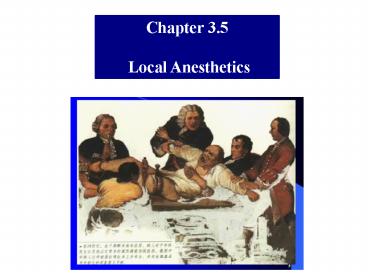Local Anesthetics - PowerPoint PPT Presentation
1 / 33
Title:
Local Anesthetics
Description:
Chapter 3.5 Local Anesthetics Local Anesthetics Definition When used locally, it can block nerve impulse transduction from local to brain. Structural Classification ... – PowerPoint PPT presentation
Number of Views:1141
Avg rating:3.0/5.0
Title: Local Anesthetics
1
Chapter 3.5 Local Anesthetics
2
Before the use of local anesthetics, to alleviate
a patients pain, surgeons must perform the
operation very fast, for example Removing
a patients breast----half minute Removing
bladder stone----one minute Modern development
of the use of drugs to induce local anesthesia
probably started in the mid-19th century. The
earliest recorded use of hypothermia as a local
anesthetic is believed to be by Larrey,
Nepoleone chief surgeon during the retreat from
Moscow. He reported that amputations carried out
at subzero temperatures has a higher survival
rate than those in warmer conditions. In 1848,
Arnott reported that he had used a pigs bladder
filled with ice to alleviate pain.
3
These drugs are applied locally and block nerve
conduction of sensory impulses from periphery to
the CNS.
4
Mechanism of action of local anesthetics These
agents are believed to act by inhibiting sodium
channels of the nerve membrane
5
Local Anesthetics
- Definition
- When used locally, it can block nerve impulse
transduction from local to brain. - Structural Classification
- esters,amides,aminoesters,aminoketones,aminoformat
e,amidines ect..
6
Discovery of Cocaine
In 1884, when studying the effects of cocaine on
fatigue, a colleague of Koller reported that the
drug numbed his tongue. Koller then investigated
this claim and found that cocaine hydrochloride
caused local anesthesia. In 1884,
cocaine was widely used as a local anesthetics.
7
Cocaine is addictive, and has many other side
effects. People modified its structures and
discovered procaine in 1904.
8
Esters Local Anesthetics
- Esters local anesthetics have common basic
structure, that is, the aromatic acid and amino
alcohol. Procaine Hydrochloride is the
representative drug. - Procaine was obtained through the structural
modification of natural alkaloid Cocaine.
9
Discovery of Procaine
- From Cocaine to Procaine
- Benzoate moiety is very important
- Methoxycarbonyl is not needed for maintaining of
activity - Tropane bicycles moiety is not necessary
- Methyl amino benzoate have local anesthetic
effect - The aminoalkyl side chain is very important
10
Discovery of Procaine
- Benzoate moiety is very important
11
Discovery of Procaine
- Methoxycarbonyl is not needed for maintaining
activity
12
Discovery of Procaine
- Tropane bicycles moiety is not necessary
13
Discovery of Procaine
- Methyl amino benzoate have local anesthetic
effect - The aminoalkyl side chain is very important
14
Procaine Hydrochloride
HCl
15
Physicochemical Properties
- White crystal or crystal powder
reducibility
hydrolysis
distinguished reaction
16
Preparation of Procaine Hydrochloride
17
Metabolism of Procaine
- Hydrolyzed to p-aminobenoic acid and N,
N-diethylaminoethanol
- 80 of the former product is vented via urine, or
vented via combination
- All the latter product is vented via urine
- Other part is vented via de-amino, de-hydroxyl,
and oxidation
18
Modification on Phenyl
- Steric hindrance
?lowing down hydrolysis rate ?increase the local
anesthetic effect
Other stable functional group
19
Amides local anesthetics
- Discovery of Lidocaine is based on the
investigation of the chemical structure of
Gramine, an alkaloid.
20
Lidocaine Hydrochloride
- (2-(Diethylamino)-N-(2,6-dimethylphenyl)
acetamide hydrochloride monohydrate) - N-(2, 6-????)-2-(????)??????????
21
- Prepared in 1943
- Screened from 57 analogues
- The local anesthetic effect is 2 to 9 times
- higher than that of Procaine
- Maintaining time delays one times
- Toxicity relatively higher
22
- Amide bond is stable than ester bond
- Two vicinal methyl groups introduce steric
hindrance
- Not easier to be hydrolyzed either in acidic or
basic - atmosphere
- The hydrolysis rate by enzyme inside body is
relatively - slow
23
Metabolism of Lidocaine
N-dealkylation
oxidation
N-methylation
hydrolysis
combo
combo
oxidation
hydrolysis
lidocaine
oxidation
oxidation
combo
combo
24
Preparation of Lidocaine
25
Aminoketone Local Anesthetics
Falicaine
Dyclonine Hydrochloride
26
Aminoether Local Anesthetics
Quinisocaine
Pramocaines
27
Aminoformate Local Anesthetics
Carbizocaine
Diperodon
28
Amidine Local Anesthetics
Phenacaine
29
Structure and Action of Local Anesthetics
- Usually including three basic moiety?lipophilic
aromatic ring?middle functional
linker?hydrophilic amino group. The lipophilic
moiety guaranty the suitable lipo-solubility.
Hydrophilic amino moiety usually is tertiary
amino, this in one hand guaranties the suitable
hrdro-solubility for transportation while in
another hand offer the structural basis for
combination with Na ion channel. - Act on sodium ion channel of nerve cell membrane,
low down the excitation of nerve cell, therefore
block the transmission of nerve impulse.
30
Dissociation and Action of Local Anesthetics
Entrance to channel for binding with receptor is
blocked for ionic conjugated acid
extracellular fluid
Non-ionic free base Permeates cell membrane and
enters into cell
Binding of ionic conjugated acid with receptor
blocks the ion channel
Cell membrane
intracellular fluid
31
Butyrocaine and Amides are able to form zwitterion
Non-ionic
zwitterionic
zwitterionic
Non-ionic
32
SAR of Local Anesthetics
Crucial factor for stability. Length of action
time sequence affected by this
moiety, Intensity sequence
Could be aromatic ring or hetero aromatic ring.
Greater effects when modified. The intensity
sequence,
Lipophilic moiety
linker moiety
hydrophilic moiety
Usually sec-amine, tertiary amine, pyrrolidine,
piperidine morpholine.Tertiary amine is mostly
used. pKa 7.57.9, It is ionic compound under
physiological atmosphere
Electron-donor group at para- or
ortho-position help the formation of zwitterion,
therefore increase the activity. When replaced
by electron- withdraw group, the
activity decrease.
2-3 carbons are the most optimal length
Insertion of group like CH2, -O- between phenyl
and carbonyl will destroy zwitt -ertions
structure, therefore low down the activity. If
inserted some conjugated group like CHCH-, the
activity will be maintained. The amide structure
is also Able to form zwitterions
33
examples
The anesthetic activity of thiocaine is twice
than that of procaine
The anesthetic effect of Procainamide is only 1
of procaine. This drug is mainly used for
treat- ment of arrhythmia































